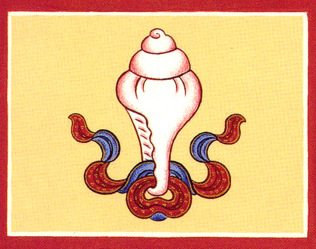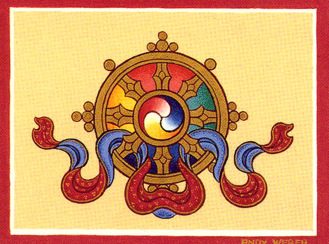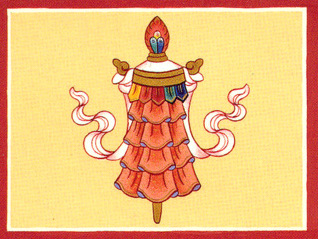The Eight Auspicious Symbols of Buddhism
In the ancient Time of Hindu mythology, they have been established signs of good fortune, and Tibetan Buddhism has a group of eight symbols that are considered to be the oldest and most well-known. These eight auspicious symbols include the golden fish, the parasol, the vase of treasure, the lotus flower, the conch shell, the infinite Knot, the wheel, and the flag.
Table of Contents
The Golden Fish
In Tibetan, it is known as Sernya. As human beings, we must live through samsara, or the endless cycle of birth, death, and rebirth that entails suffering at every stage. The Buddha’s teachings set us on the path to liberation from samsara; the golden fish symbolizes that liberation, a creature of joy, at one in its element, living a life of spontaneity with no pain or fear perishing in self-created suffering. The fish symbol is significant in Hinduism, Jainism, and Christianity. In Buddhism, the fish also represents fertility and abundance. It is often beautifully depicted as a carp, which in Asia is considered sacred because of its elegance, size, and long lifespan. Essentially, the golden fish is an aspirational symbol, teaching man that the spiritual bliss beyond samsara is infinitely more beautiful than anything he can experience in earthly life.

The Tibetan Parasol or Umbrella
In Tibetan, it is known as Dhug. In nature, the dome of the sky arches above the mountain. The parasol in Buddhism is symbolically a device that casts a shadow, and therefore, offers protection from heat. Also, in Indian mythology, the parasol has traditionally been associated with royalty. Held above the head conveys honor and reverence, and hence the Buddha is often depicted sitting under a decorative parasol. The concept of the parasol providing shelter from the sun’s heat translates into the Buddha’s teachings protecting us from the “heat” of hostile forces like greed, lust, and suffering, obstacles in the path of the spirit’s journey towards enlightenment. The Tibetan parasol is inspired both by Indian and Chinese designs used by royalty. Its wooden spoke is topped by a dome-shaped cover, with a silky “skirt” hanging from the rim. The dome represents wisdom and the skirt, compassion, both of these being essential Buddhist values.

The Vase of Treasure
In Tibetan, it is known as Bumpa. The urn closely resembles the round-bellied, slim-necked Kalash of Hinduism. A large jewel on top gives the pot its other name, the Vase of Treasure. The jar is symbolic of limitless wealth. Traditionally, Buddhist treasure vases are filled with sacred materials and placed upon altars. They are buried near springs and mountain passes to believe that they are conducive to a harmonious environment. It is thought that their presence attracts wealth. Of greater significance is that the urn represents the abundant spiritual wealth of the Buddha. No matter how much he gives away, more will always be forthcoming.

The Lotus Flower
The lotus is called Pema in Tibetan and Padma in Sanskrit. Rooted in muddy slime, the lotus rises through the water to emerge into the sun, progress that mirrors the journey of man’s soul. Mired in suffering and sin, we pass through varied experiences before emerging into the sun of enlightenment. Many plants grow above water; only the lotus, whose sturdy stem allows it to clear the water surface and stand steadfast.
It is said that our hearts are like the closed petals of a lotus. Imbibing Buddhist virtues will enable the lotus to blossom into its full beauty. This is why the Buddha is often depicted seated on a lotus. The white lotus represents the purity of mind and an evolved spirit. The pink lotus is matchless in its perfection and therefore emblematic of the Buddha himself. A blue lotus is symbolic of the spirit’s conquest of the senses, while a red bloom is associated with Avalokiteshvara, the Compassionate One.

The Conch Shell
The conch shell is called Dhunk in Tibetan. A right-spiraled conch is a rare find and is considered sacred in Buddhism. Its direction is thought to be consonant with the movement of celestial bodies in the universe. Curiously, the whorls of hair on the Buddha’s head are right-directional; so is his body hair and the curl between his eyebrows. His navel, too, is shaped like the right-turning conch shell. Today, the conch is used as a summons to prayer. During rituals, it is used to hold holy water and as a musical instrument. The conch proclaims the widespread influence and sovereignty of Buddha’s teachings. It is emblematic of great spiritual power, and its resonance is thought to cast out evil spirits.

The Infinite Knot
It is also known as Pata in Tibetan. Dharma is continuous and inexorable, while Time is but an illusion. The Knot of Infinity symbolizes that truth. The search for enlightenment need not mean giving up worldly responsibilities. The Knot is a representation of the Buddha’s teaching that religious thought and worldly life are intertwined. The Infinite Knot is a line without a beginning or end that radiates both calm and movement. It represents the idea that everything in this world is interconnected. It is also symbolic of the Buddha’s infinite compassion. Initially, this symbol was associated with Vishnu and his abiding love for his consort Lakshmi, goddess of wealth. You can find the endless knot symbol on various inspirational products such as infinite knot pendants, permanent knot decor, and more.

The Wheel
It is called Khorlo in Tibetan. The eight-spoke wheel Dharmachakra, also known as the Wheel of Law, is among the oldest and best known Buddhist symbols, going back to the Time of the great Buddhist king Asoka in India. The wheel in its entirety encapsulates the Buddha’s teaching. Its eight spokes represent the Buddha’s Noble Eightfold Path, which leads to the spiritual enlightenment of all sentient beings. The circular shape invokes the idea of perfection – following the path of dharma is the best way out of the endless cycle of samsara. The hub of a wheel is its focal point. Here, it stands for inner discipline, which is the essence of meditation practice. The rim of the wheel connects the spokes and holds together the entire structure. This is mindfulness (Samadhi), or ‘living in the moment’ a cornerstone of Buddhist teachings. The forward motion of the wheel points to the spread of the Buddha’s doctrine. Ever since Sakyamuni expounded on his doctrine of enlightenment, the Wheel of Dharma has never stopped rolling, from India through virtually all of Asia and in modern times, the West as well. Many Asian countries have incorporated the Dharmachakra into their national flags.

The Flag or The Victory banner
It is called Gyalshan in Tibetan. n Hindu mythology, the flag or Banner of Victory is often featured as a military standard. In Buddhism, it is symbolic of the conquest of ignorance. It is also symbolic of the Buddha’s triumph over the four Maras, or obstacles on the path to enlightenment. These are passion, greed, emotional degradation, and the fear of death. To achieve enlightenment, all sentient beings must conquer these hurdles. Traditionally, cylindrical banners made of beaten copper are placed at the four corners of Buddhist temples. They point to the spread of Buddhist doctrine in four directions and the Buddha’s victory over the Maras.
These Eight symbols appear throughout Buddhist iconography both separately and all together. At Buddha Groove, you’ll find these symbols beautifully adorning jewelry pieces, home décor, and various tools for spiritual rituals. Choose from sterling silver pendants for each of the eight characters or browse wall hangings featuring artistic depictions. You’ll also find bracelets lined with the symbols and traditional singing bowls and prayer wheels crafted with Auspicious Symbol reliefs.

Recent Posts
The Ultimate Guide to Tibet Tours, Travel, and Trekking Adventures
How to Explore Tibetan Culture
Exploring Lhasa:The Heart of Tibet
All Categories
- About Tibet
- book a Tibet tour
- Buddhism Practice
- Budget Tour
- China-Tibet Train
- Customized Tibet tour
- Historical Sites
- Hot Springs in Tibet
- News
- Photography in Tibet
- Tibet attraction
- Tibet Group Visa
- Tibet Motorcycle Tour
- Tibet Small Group Tours
- Tibet Tours and Tibetan Tour Guide
- Tibet Train
- Tibet Travel FAQs
- Tibet Travel Information
- Tibet Travel News
- Tibet Travel Permit Update
- Tibet Travel Prices Rises
- Tibet Trek
- Tibet Trekking Tour
- Tibet weather and climate
- Tibet Wildlife animals
- Tibet Winter Tour
- Tibetan Buddhism
- Tibetan Cultural Features
- Tibetan Culture and Poeple
- Tibetan Festivals
- What to see in Tibet



